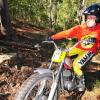It's fairly dry here and the original zinc plated spokes on trials bikes made in the 1970s are still serviceable 45 years later but do look dowdy. New zinc plate spokes here look good for about 15 years. If you live in a wet area or at the coast they will start to look dull sooner than that. Stainless steel spokes will look great for hundreds of years but how much longer do you think the bike needs to look nice?
I use both types, chosen mainly to provide the original look of the particular bike. Most of my Spanish bikes came with stainless spokes so that is what goes back on and all of my Japanese bikes came with zinc plated spokes and that is what goes back on. One Spanish bike came with plain steel (uncoated) spokes and I used stainless spokes on it. If I lived somewhere that it rains a lot or near the coast I would use stainless steel spokes on every wheel rebuild.
Maybe you have access to very cheap zinc plated spokes to get your costing of double for stainless, but what I've paid recently is for genuine TY spokes, one wheel costs about $120 while a set of aftermarket stainless spokes for a TY or a Bultaco is between $120 and $180.


